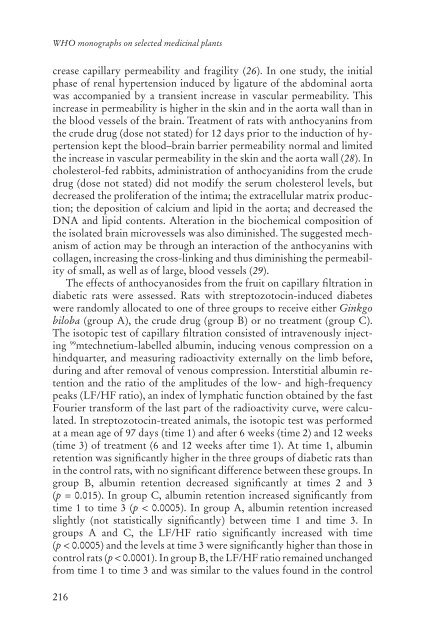WHO monographs on selected medicinal plants - travolekar.ru
WHO monographs on selected medicinal plants - travolekar.ru
WHO monographs on selected medicinal plants - travolekar.ru
Create successful ePaper yourself
Turn your PDF publications into a flip-book with our unique Google optimized e-Paper software.
<str<strong>on</strong>g>WHO</str<strong>on</strong>g> <str<strong>on</strong>g>m<strong>on</strong>ographs</str<strong>on</strong>g> <strong>on</strong> <strong>selected</strong> <strong>medicinal</strong> <strong>plants</strong><br />
crease capillary permeability and fragility (26). In <strong>on</strong>e study, the initial<br />
phase of renal hypertensi<strong>on</strong> induced by ligature of the abdominal aorta<br />
was accompanied by a transient increase in vascular permeability. This<br />
increase in permeability is higher in the skin and in the aorta wall than in<br />
the blood vessels of the brain. Treatment of rats with anthocyanins from<br />
the c<strong>ru</strong>de d<strong>ru</strong>g (dose not stated) for 12 days prior to the inducti<strong>on</strong> of hypertensi<strong>on</strong><br />
kept the blood–brain barrier permeability normal and limited<br />
the increase in vascular permeability in the skin and the aorta wall (28). In<br />
cholesterol-fed rabbits, administrati<strong>on</strong> of anthocyanidins from the c<strong>ru</strong>de<br />
d<strong>ru</strong>g (dose not stated) did not modify the se<strong>ru</strong>m cholesterol levels, but<br />
decreased the proliferati<strong>on</strong> of the intima; the extracellular matrix producti<strong>on</strong>;<br />
the depositi<strong>on</strong> of calcium and lipid in the aorta; and decreased the<br />
DNA and lipid c<strong>on</strong>tents. Alterati<strong>on</strong> in the biochemical compositi<strong>on</strong> of<br />
the isolated brain microvessels was also diminished. The suggested mechanism<br />
of acti<strong>on</strong> may be through an interacti<strong>on</strong> of the anthocyanins with<br />
collagen, increasing the cross-linking and thus diminishing the permeability<br />
of small, as well as of large, blood vessels (29).<br />
The effects of anthocyanosides from the f<strong>ru</strong>it <strong>on</strong> capillary filtrati<strong>on</strong> in<br />
diabetic rats were assessed. Rats with streptozotocin-induced diabetes<br />
were randomly allocated to <strong>on</strong>e of three groups to receive either Ginkgo<br />
biloba (group A), the c<strong>ru</strong>de d<strong>ru</strong>g (group B) or no treatment (group C).<br />
The isotopic test of capillary filtrati<strong>on</strong> c<strong>on</strong>sisted of intravenously injecting<br />
99 mtechnetium-labelled albumin, inducing venous compressi<strong>on</strong> <strong>on</strong> a<br />
hindquarter, and measuring radioactivity externally <strong>on</strong> the limb before,<br />
during and after removal of venous compressi<strong>on</strong>. Interstitial albumin retenti<strong>on</strong><br />
and the ratio of the amplitudes of the low- and high-frequency<br />
peaks (LF/HF ratio), an index of lymphatic functi<strong>on</strong> obtained by the fast<br />
Fourier transform of the last part of the radioactivity curve, were calculated.<br />
In streptozotocin-treated animals, the isotopic test was performed<br />
at a mean age of 97 days (time 1) and after 6 weeks (time 2) and 12 weeks<br />
(time 3) of treatment (6 and 12 weeks after time 1). At time 1, albumin<br />
retenti<strong>on</strong> was significantly higher in the three groups of diabetic rats than<br />
in the c<strong>on</strong>trol rats, with no significant difference between these groups. In<br />
group B, albumin retenti<strong>on</strong> decreased significantly at times 2 and 3<br />
(p = 0.015). In group C, albumin retenti<strong>on</strong> increased significantly from<br />
time 1 to time 3 (p < 0.0005). In group A, albumin retenti<strong>on</strong> increased<br />
slightly (not statistically significantly) between time 1 and time 3. In<br />
groups A and C, the LF/HF ratio significantly increased with time<br />
(p < 0.0005) and the levels at time 3 were significantly higher than those in<br />
c<strong>on</strong>trol rats (p < 0.0001). In group B, the LF/HF ratio remained unchanged<br />
from time 1 to time 3 and was similar to the values found in the c<strong>on</strong>trol<br />
216

















